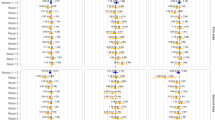Abstract
This study aimed to determine the effect of the presence of under-5 siblings (⩾1) in a household on childhood malnutrition in urban Bangladesh. During 2000 and 2013, a total of 16 948 under-5 children were enrolled in the Diarrhoeal Disease Surveillance of icddr,b. Under-5 siblings were categorised as ⩾1 and none except the child himself. In univariate analysis, the presence of siblings was associated with 1.13 (risk ratios=1.13; 95% CI:1.06–1.20) times higher risk of being stunted, 1.17 (1.09–1.25) times for wasted and 1.19 (1.13–1.26) times underweight compared with their peers who did not have siblings. In multivariate analysis, such associations remained significant for stunting (1.08; 1.01–1.15), wasting (1.12; 1.04–1.21) and underweight (1.13, 1.06–1.19) after controlling for possible confounders such as age of child, sex, parental education, maternal employment, family size, wealth quintile and time (year). The presence of under-5 siblings increases the risk of malnutrition in children in urban Bangladesh.
This is a preview of subscription content, access via your institution
Access options
Subscribe to this journal
Receive 12 print issues and online access
$259.00 per year
only $21.58 per issue
Buy this article
- Purchase on Springer Link
- Instant access to full article PDF
Prices may be subject to local taxes which are calculated during checkout
Similar content being viewed by others
References
Farr NM, Nelson. BD . Child Mortality In Developing Countries The Massgeneral Hospital For Children Handbook Of Pediatric Global Health. Springer 2014; 3–12.
Nnamuchi O . Millennium Development Goal 4, Children's Health and Implementation Challenges in Africa: Does a Human Rights Based Approach Suffice? U Chi Int'l L Rev 2014; 11: 103–161.
United Nations Children’s Fund WHO, T W B. UNICEF-WHO-World Bank Joint Child Malnutrition Estimates: Levels & Trends in Child Malnutrition. Geneva Group, Washington DC, USA: UNICEF, WHO, World Bank, 2012.
HB Urke. Social Determinants of Chronic Child Malnutrition in Peru: Comparison of a National Sample to a Sample from the Rural Andes from the Peru 2006–2008. Measure DHS Project 2010.
Raj A, McDougal LP, Silverman JG . Gendered effects of siblings on child malnutrition in south asia: cross-sectional analysis of demographic and health surveys from Bangladesh,India, and Nepal. Matern Child Health J 2014; 19: 1–10.
Das SK, Ahmed S, Ferdous F, Farzana FD, Chisti MJ, Leung DT et al. Changing emergence of Shigella sero-groups in Bangladesh: observation from four different diarrheal disease hospitals. PLoS One 2013; 8: 62029.
Onyango AW, De Onis M . Traning Course on Child Growth Assessment: WHO Child Growth Standards. Geneva, Switzerland: WHO, 2008.
en.wikipedia.org/wiki/Sibling. Wikipedia, the free encyclopedia. accessed on 25 January 2015.
Barros AJ, Hirakata VN . Alternatives for logistic regression in cross-sectional studies: an empirical comparison of models that directly estimate the prevalence ratio. BMC Med Res Methodol 2003; 3: 21.
Biddulph J . Priorities and practice in tropical paediatrics. J Paediatr Child Health 1993; 29: 12–15.
Canning D, Schultz TP . The economic consequences of reproductive health and family planning. Lancet 2012; 380: 165–171.
Ahmed T, Mahfuz M, Ireen S, Ahmed AS, Rahman S, Islam MM et al. Nutrition of children and women in Bangladesh: trends and directions for the future. J Health Popul Nutr 2012; 30: 1.
Acknowledgements
Hospital surveillance was funded by icddr,b and the Government of the People’s Republic of Bangladesh through IHP-HNPRP. icddr,b is also thankful to the Governments of Australia, Bangladesh, Canada, Sweden and the United Kingdom for providing core/unrestricted support.
Author information
Authors and Affiliations
Corresponding author
Ethics declarations
Competing interests
The authors declare no conflict of interest.
Rights and permissions
About this article
Cite this article
Das, J., Das, S., Hasan, T. et al. Childhood malnutrition in households with contemporary siblings: a scenario from urban Bangladesh. Eur J Clin Nutr 69, 1178–1179 (2015). https://doi.org/10.1038/ejcn.2015.75
Received:
Revised:
Accepted:
Published:
Issue Date:
DOI: https://doi.org/10.1038/ejcn.2015.75



